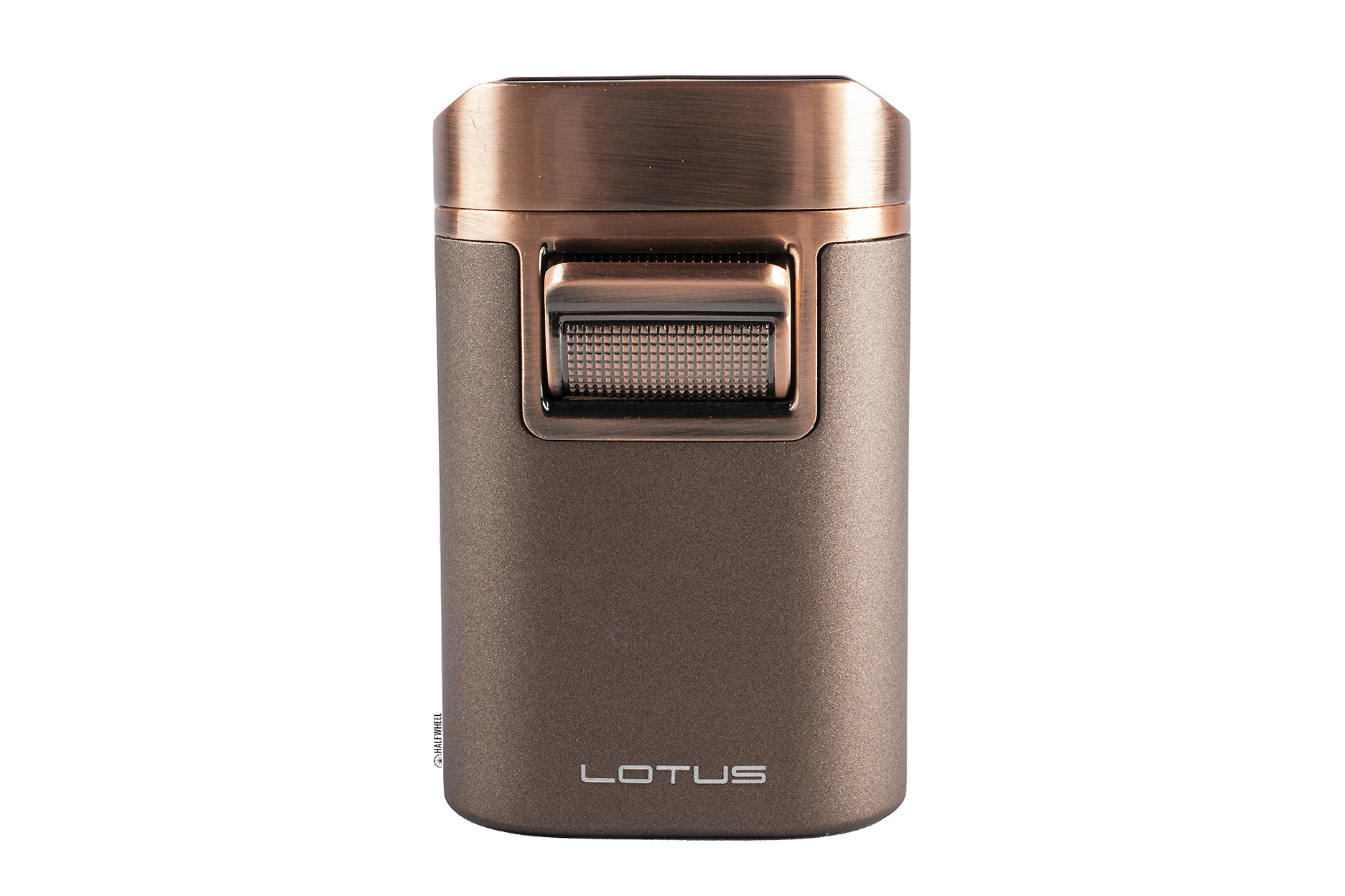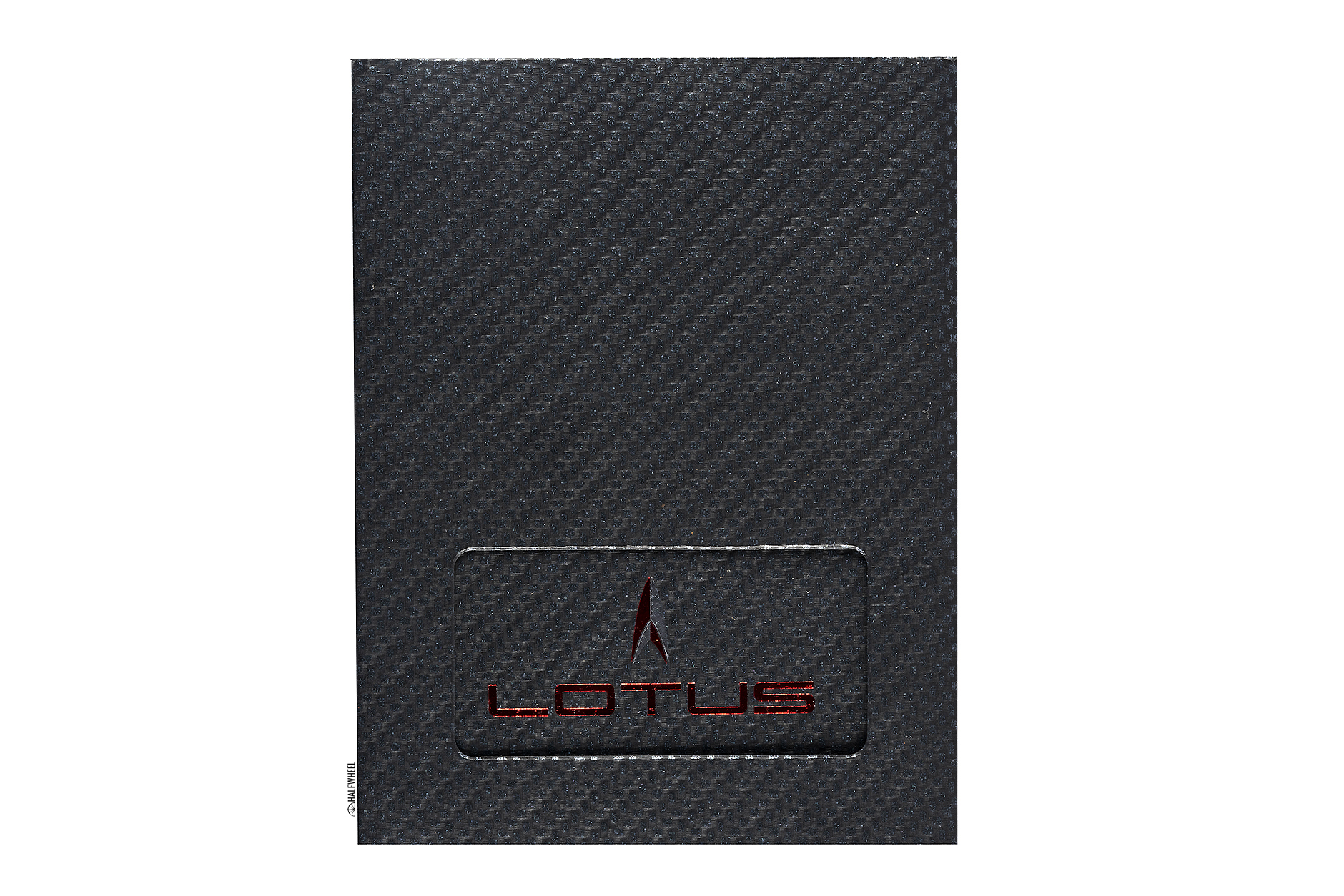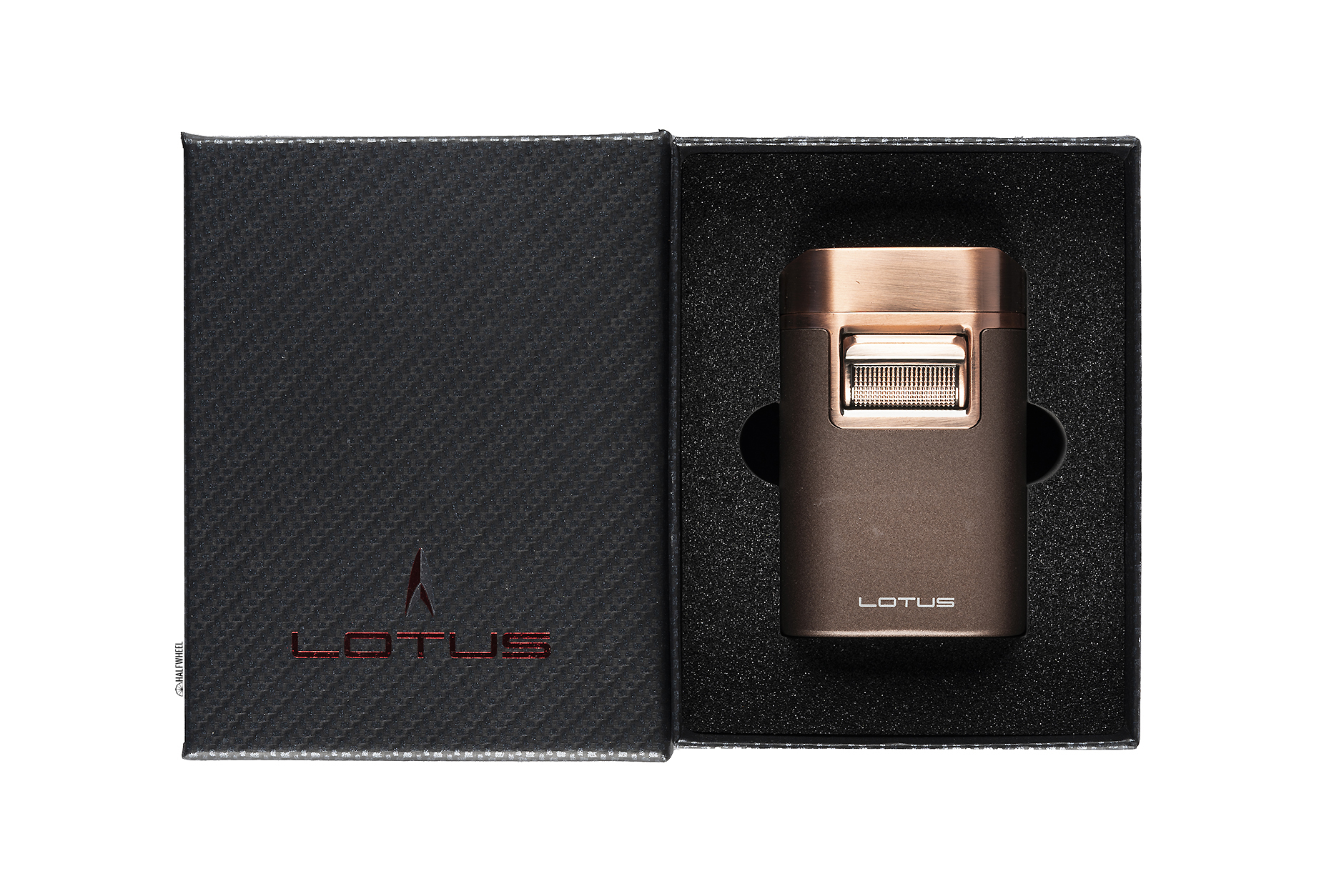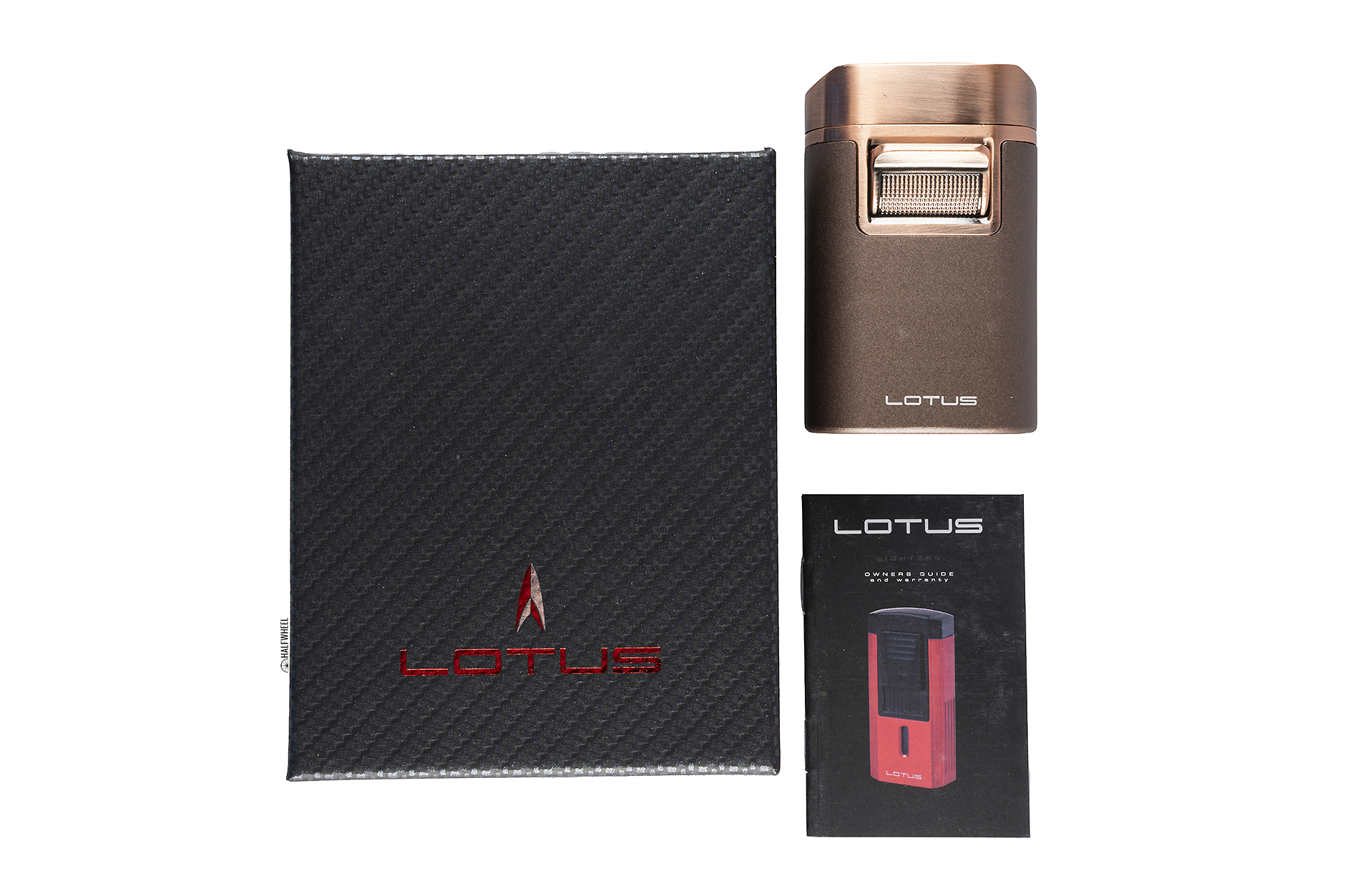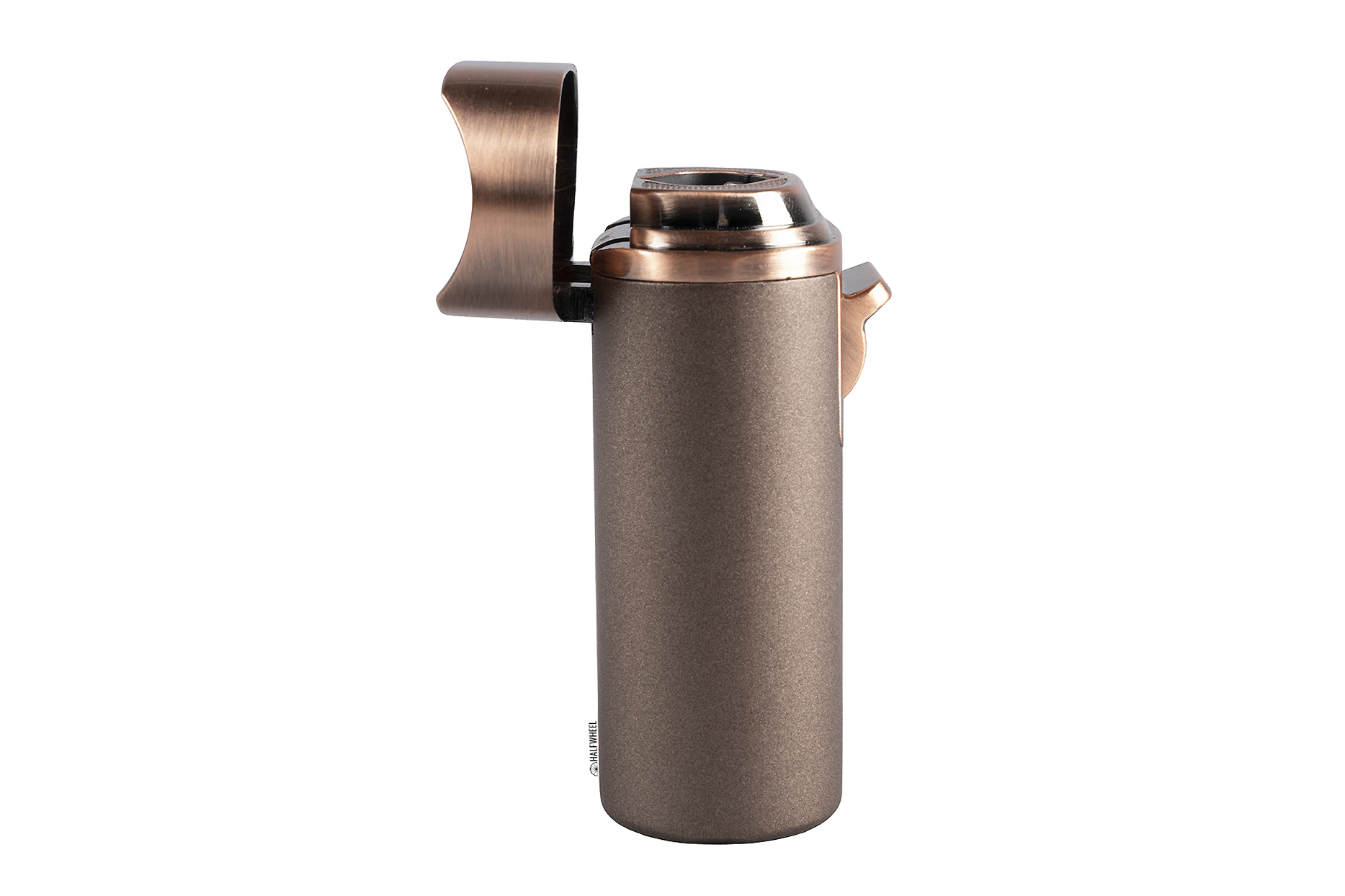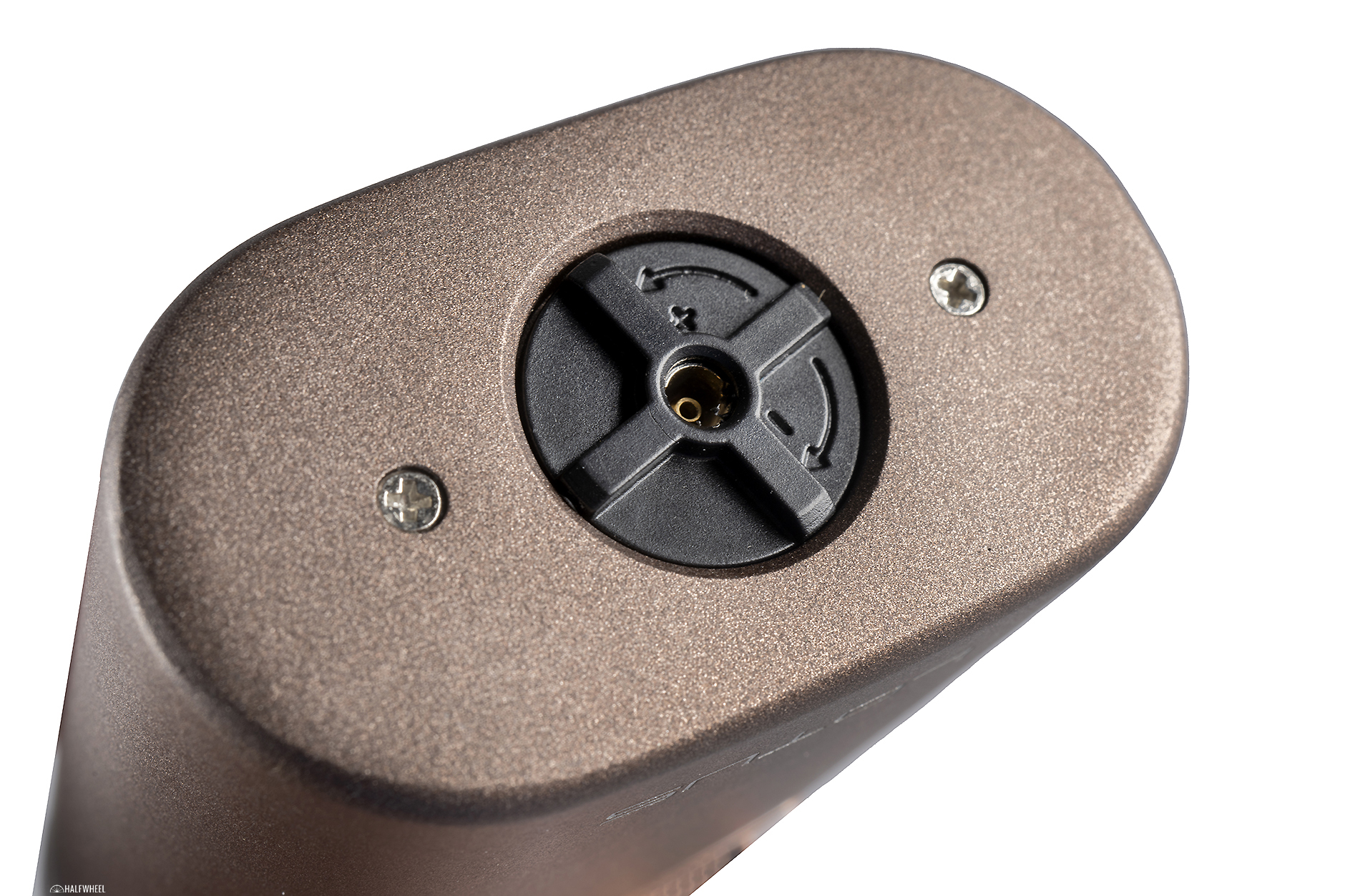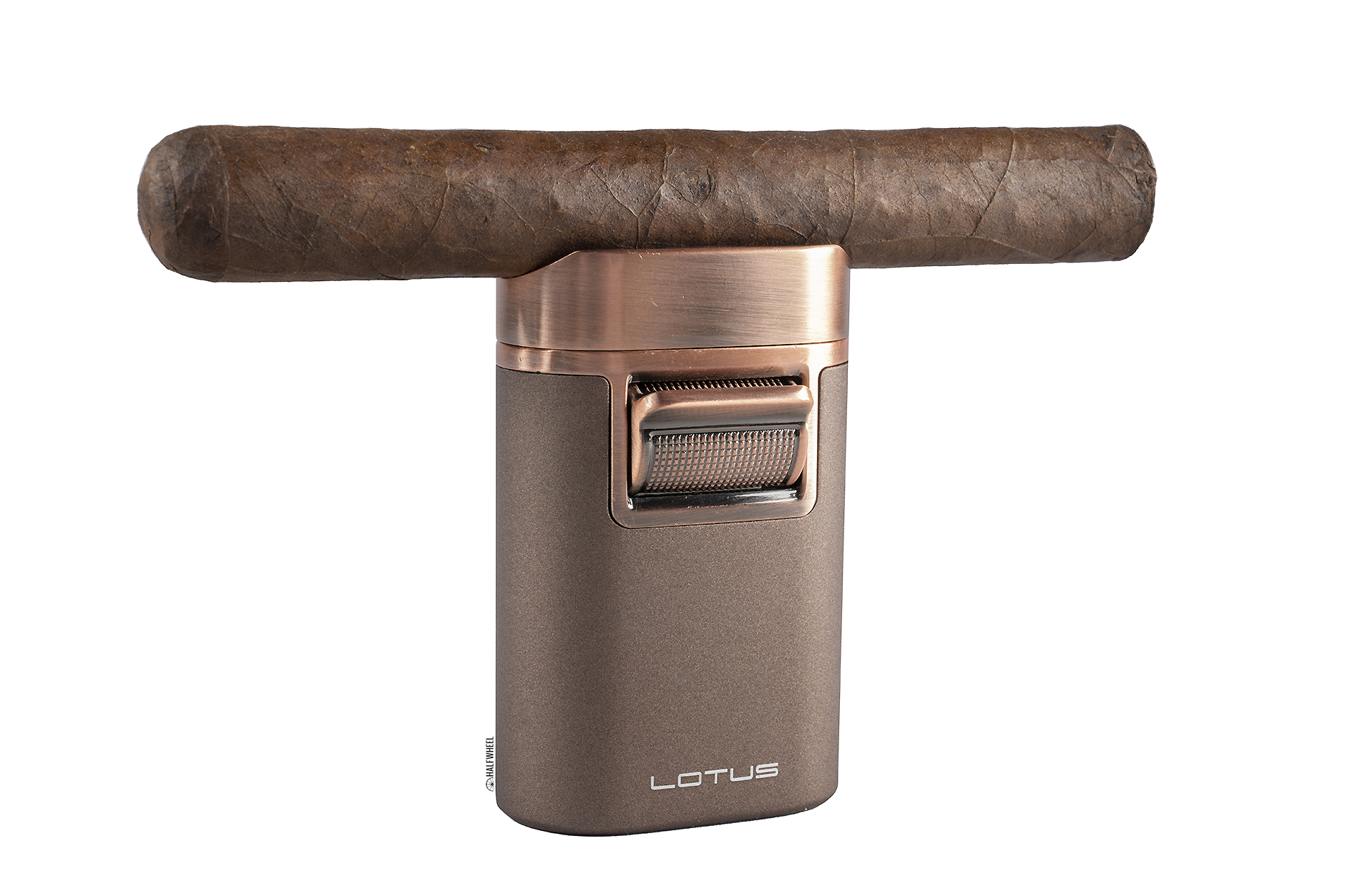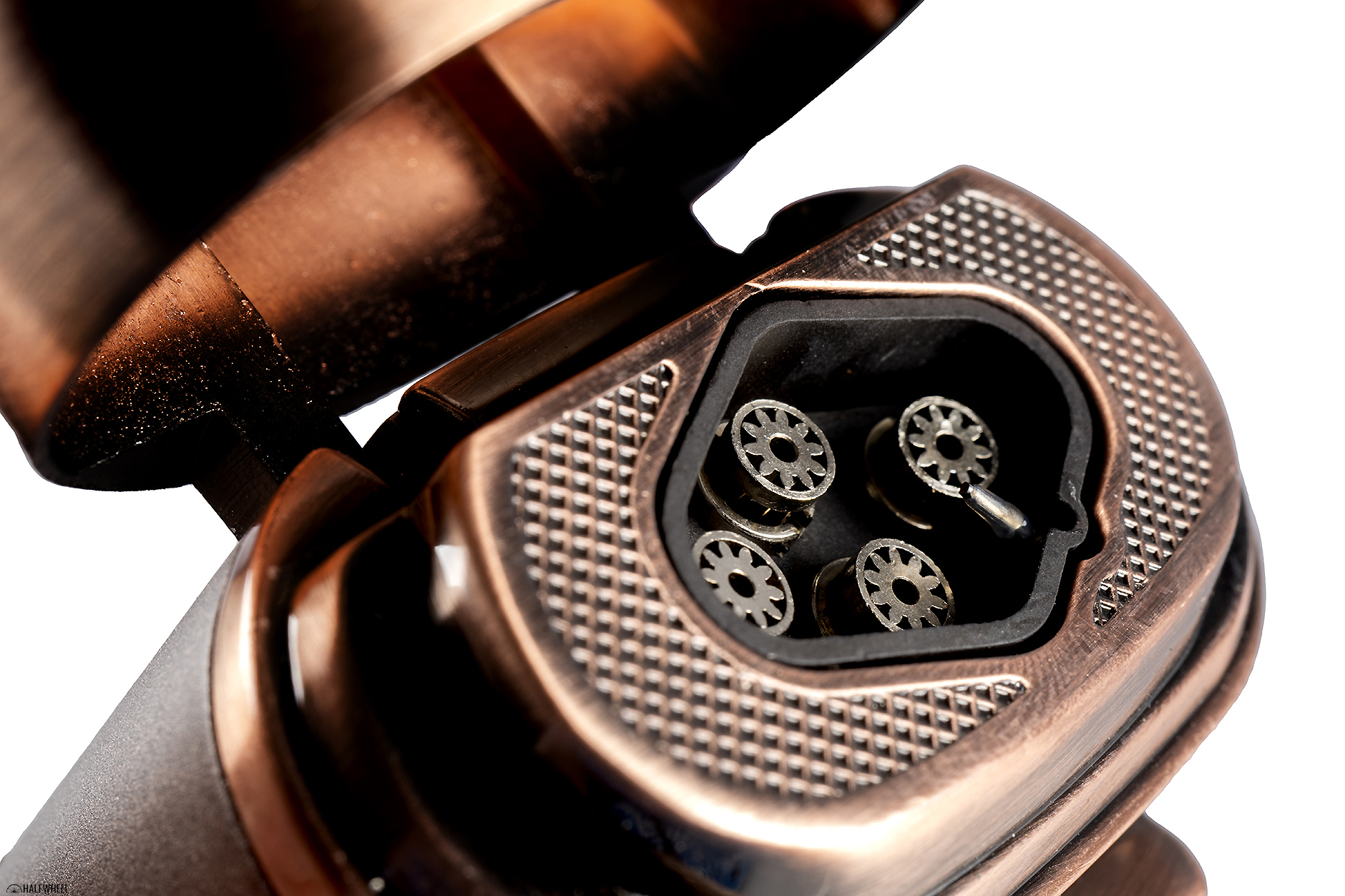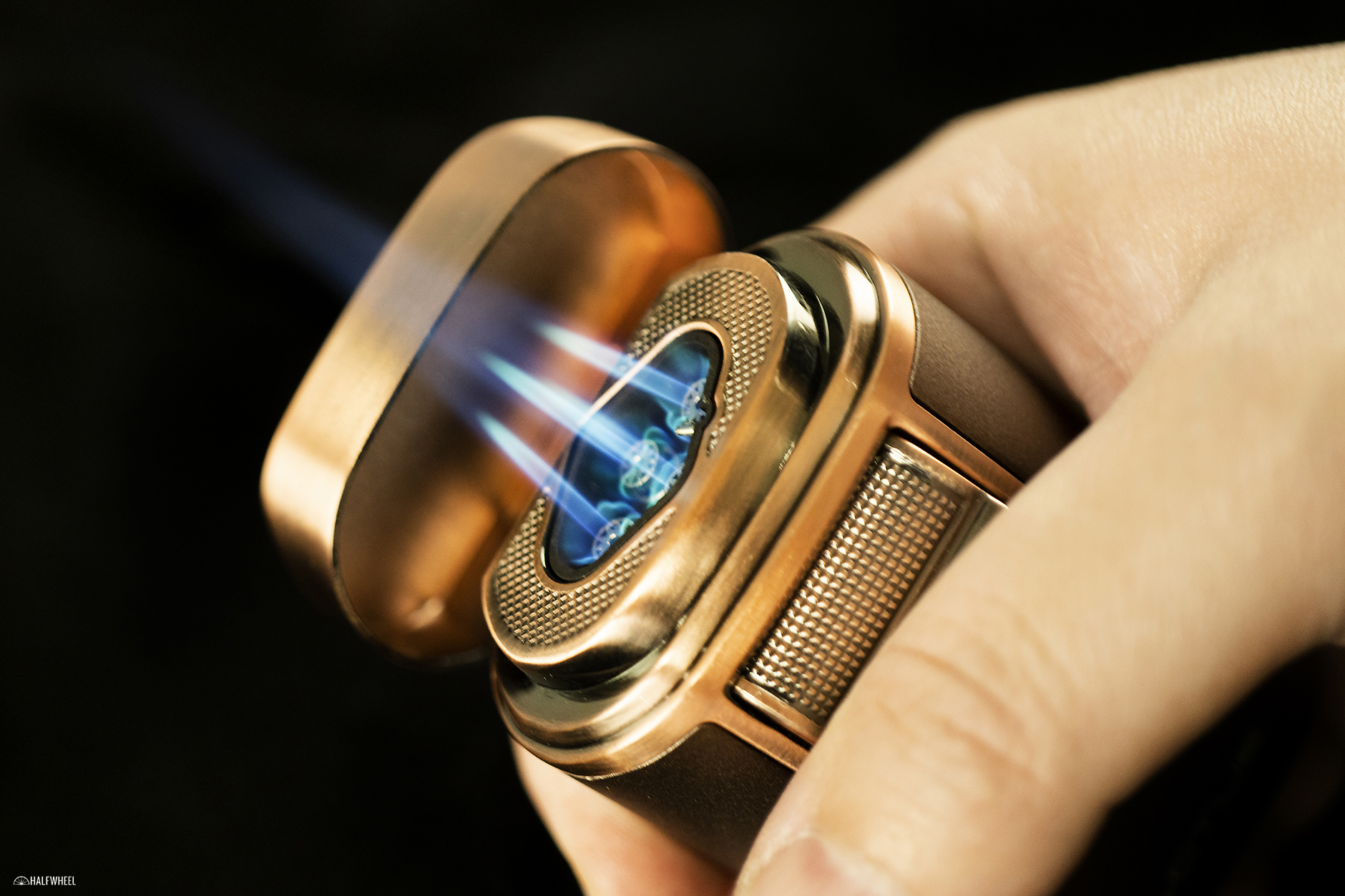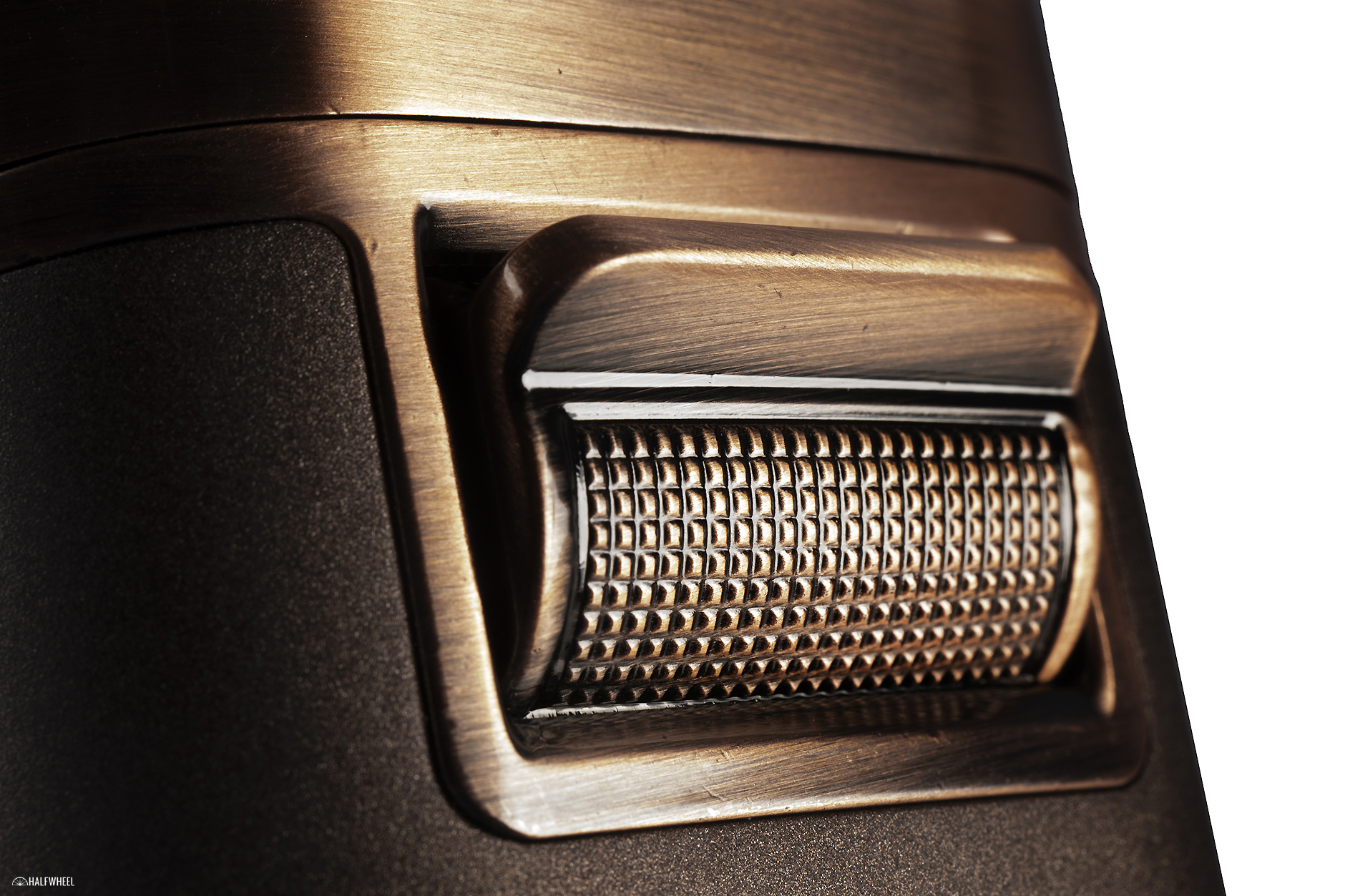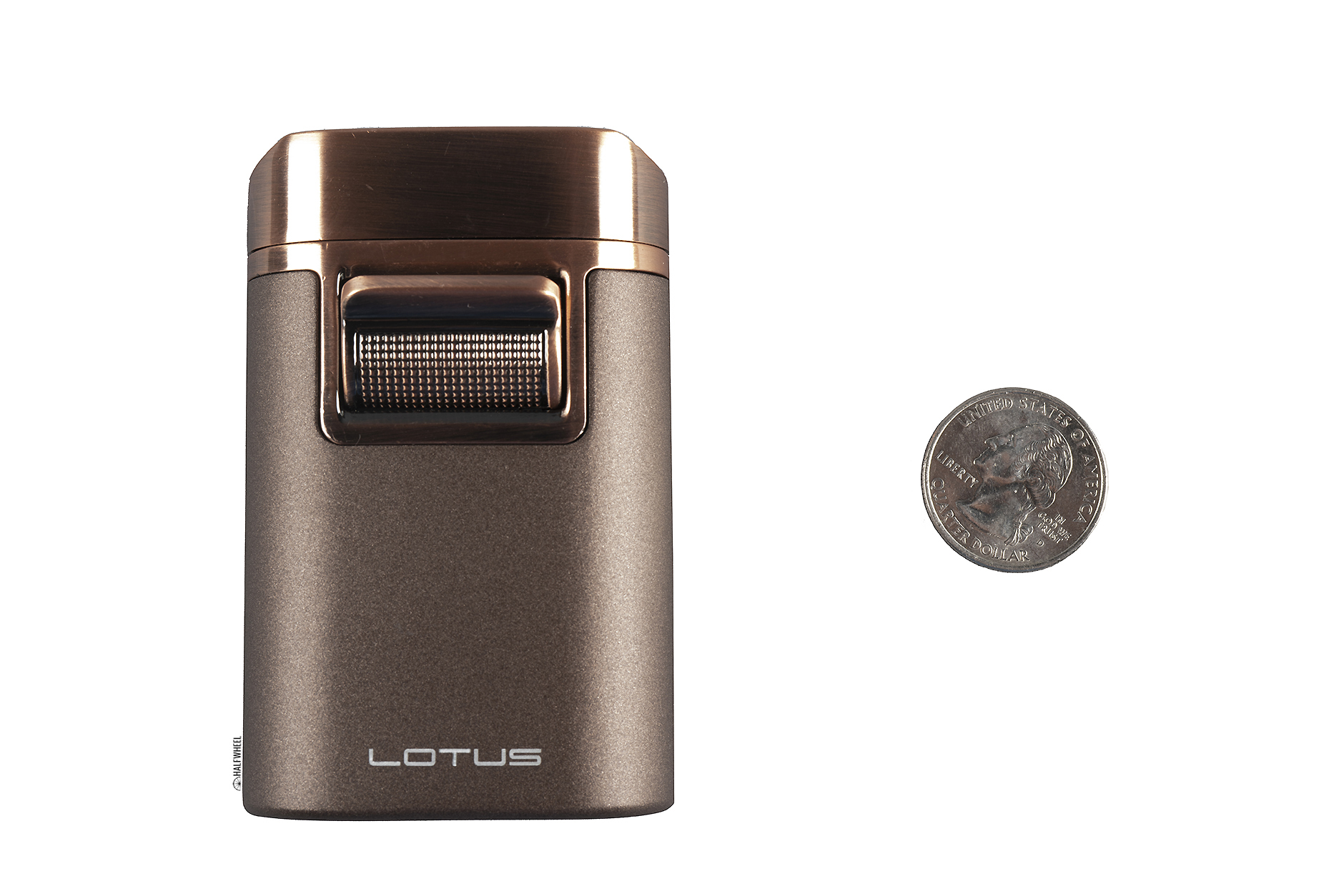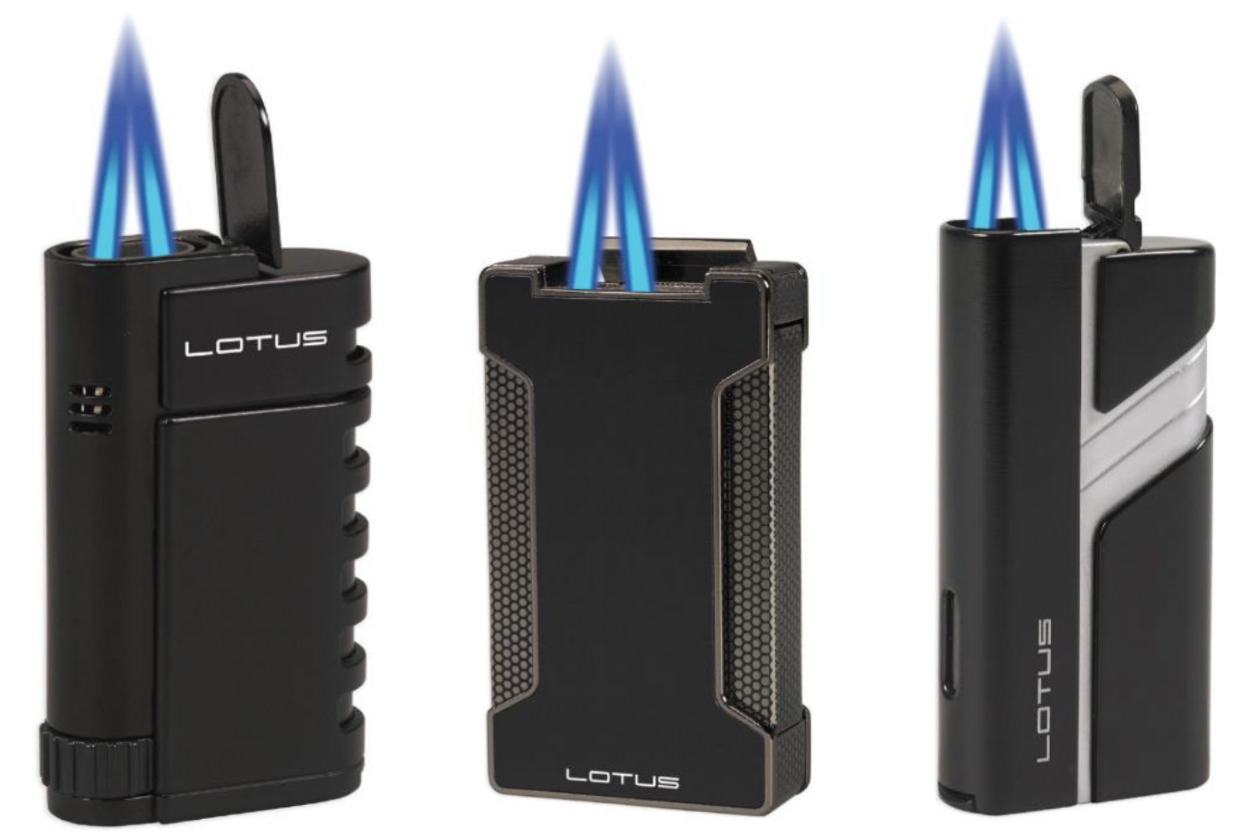As I move through the world, I find it interesting to notice what catches my eye about something, and that applies to the world of cigar lighters. Sometimes it is the color, the size, the design of the body, a splash of flash, of a healthy dose of subtlety.
In the case of the Lotus Brawn, it was the ignition mechanism.
When I stopped by the Lotus Group booth at the 2022 Tobacco Plus Expo, I was given the walkthrough of the company’s new products, this particular lighter caught my eye because of its large, cylinder-like ignition. But then I opened up the lid—which is curved so as to offer a place to rest your cigar—and found the jet torches arranged so that they would appear to balance the strength of four flames with the precision of smaller lighters. Seeing that, it immediately solidified this as a lighter I wanted to spend some time with and review.
WHAT IS IT?
The Lotus Brawn is a tabletop, quadruple flame torch lighter that offers a curved lid that can serve as a cigar rest when you aren’t actively lighting your cigar. In terms of other features, there is also an oversized flame adjuster on the base of the lighter. It measures 3.25 x 2 x 1.25 inches, putting it on the smaller end of the tabletop lighter spectrum. It weighs in at approximately 7.7 ounces—just under half a pound—a weight that is due in part to the all-metal body.
HOW MUCH DOES IT COST?
$49.95. The lighter comes with a two-year limited warranty.
HOW DOES IT WORK?
The Lotus Brawn requires two steps in order to get the torch flames going: first, the lid needs to be flipped up, and then the ignition mechanism needs to be pressed down. Pressing the ignition down starts the flow of butane and provides the spark that ignites that fuel and gets the four jets burning, with that spark coming just past the midway point of its full range. Continue holding the ignition down to keep the flame going, and when done lighting the cigar, simply release the ignition lever to stop the flow of butane and extinguish the flames.
WHAT MAKES IT SPECIAL?
The Lotus Brawn attempts to be more than just a powerful lighter, it tries to add in some precision by way of strategically placing and aligning its four jets. The power of four jet torch flames should need no explanation, but the precision is achieved by placing the jets in a diamond configuration and then angling each one inward just a bit so that they come together an inch or so above the lighter.
Given that the Brawn is a quad flame, it’s undoubtedly geared more towards people who smoke thicker ring gauge cigars and want that extra firepower, as opposed to being targeted to smokers of lanceros and coronas who would be better suited by a single flame torch. But much like a large pickup truck with a sport performance option, the Brawn tries to be more than just brute power, while doing so in a clean and classy design for a fairly affordable price.
PROS
- The Ignition Mechanism — This is what first caught my eye and attracted me to the Brawn, and several weeks of use shows that it’s not just for show. It’s very easy to use, even more when setting my thumb across the ignition as opposed to using it head-on. And while they don’t function into the use of the ignition, the rows of dots provide an additional visual layer to the design.
- The Angeled Jets — Most quadruple flame lighters are a non-starter for me, as they offer simply too much power and are seemingly just for show. In the case of the Lotus Brawn, the four flames still offer a lot of power, but angling them in a bit so that they merge to a point, it preserves a good bit of accuracy. It’s not a small single flame in that regard, but it is much better than many other quadruple flame competitors.
- The All-Metal Body — A lighter that is too heavy isn’t great, but one that offers some decent mass in the hand feels better in my opinion. The Lotus Brawn does just that, coming in at just under half-a-pound, which means it is still easy to handle while also feeling incredibly solid. And while an all-metal body might suggest the Brawn would get hot to the touch, I rarely experienced that. The lid does a good job shielding the heat, and the ignition never seemed to pick any up.
- The Flame Adjuster — If only all lighters could have a flame adjustment mechanism that is this easy to use. It is about the size of a dime with intersecting ridges that makes it easy to grab onto. It also doesn’t seem to move much during use, so readjustments will only be done when wanted, not because it shifted on its own or got accidentally nudged.
- The Cigar Rest is Very Usable — There has been a growing number of lighters offering some kind of cigar rest, and that number grew during the pandemic as some people wanted to avoid shared spaces, especially where germs might be more readily transmitted. Some have been better than others, and that goes for the Brawn’s. It’s big enough to accommodate large ring gauges and long enough to provide some stability.
- The Price is Right — This is a $50, multi-flame, tabletop lighter; a relative rarity. It’s also less expensive than the Lotus Terminator III, a triple flame table lighter with a comparable design.
- Fuel Consumption is Respectable — Any quad flame is going to go through a fair amount of fuel, and while I don’t do timed tests as to how long a full tank lasts, I never felt like I was constantly refueling this lighter.
CONS
- No Fuel Window – The lack of a fuel window is a bit of a detractor, but I will qualify it by saying that since this is a tabletop lighter and not likely to be taken out on the town, as long as you have a can of butane on hand it’s not a big thing. As I mentioned above, the Lotus Brawn never felt like a butane guzzler, so that’s definitely a positive.
- It Is Still a Lot of Flame — Like all triple and quadruple flame lighters, the Lotus Brawn offers a lot of flame, seemingly more than any cigar smoker should ever need. That means a higher likelihood of over-toasting or charring a cigar while lighting, as well as scorching the sides of smaller cigars.
- Its Weight, Possibly — This isn’t a downside for me, but I could see the lighter being a bit too heavy for some people.
- Lack of A Punch Cutter (Or Other Essential Feature) — Again, this isn’t a downside for me, but in trying to find things that I could see being objections for someone buying this lighter, the pros mentioned above might not be enough. I know a few folks who strongly prefer, possibly even require, any lighter they buy to have a punch cutter, so for those folks this one won’t clear their bar.
THE COMPETITION
- NUb Ignition Lighter ($59.99) — When I think of tabletop lighters, this is still my standard, even though it hasn’t been readily available for several years. Though I generally avoid branded items, this one won me over with its cylindrical design, solid ignition, and overall outstanding performance. The Lotus Brawn easily matches my thoughts about this lighter, while adding the cigar rest lid, giving it a slight edge if I had to pick between the two.
- Visol Rhino ($50) — While I haven’t used the Rhino, it is a very close competitor to the Brawn. It’s a side squeeze lighter that also offers a cigar rest lid and a large flame adjuster, while adding a large fuel window. The flames don’t appear to be angled in like the Brawn’s, however. I can’t say which one I’d pick, but it would be an interesting head-to-head comparison.
- JetLine Bugle Master ($59.99) — I haven’t reviewed the Bugle Master either, but it is also a close competitor thanks to a curved lid to hold your cigar and large flame adjuster, while adding a fuel window. Like the Visol Rhino, it’s a side squeeze ignition and the flames aren’t angled inward, making it more about pure firepower than trying to add in some precision.
- Colibri Quasar Table Lighter ($175) — The design-forward Quasar has also jumped up towards the top of my favorite tabletop lighters, though this one is more than triple the price of the Lotus Brawn, as well as more than four times as heavy, weighing 29.3 ounces versus 7.7 ounces for the Brawn. But if a more distinctive appearance is desirable the worth the premium for it, the Quasar is worth a look. If forced to choose, I’d still take the Brawn.
- XIKAR HP4 Quad Lighter ($134.99) — If portability is a priority in a quad flame lighter, then this is worth a look. It also features the angled jets and a very easy to adjust flame, helping to rein in the power of the four flames. If you want a quad-flame tabletop from XIKAR, the Volta ($174.99) is one to consider, though I have not reviewed it. Both are good lighters, but the price savings still has me choosing the Brawn.
- JetLine V-6 ($129) — If you want the ultimate in firepower from a lighter, the JetLine V-6 is your option, even though I found it to be simply too much. It does come with a built-in guillotine cutter, something rarely found on cigar lighter, though it’s more than twice as expensive and almost twice as heavy. The Avalanche ($79.99) is another option, though I found it has some issues of its own. The Brawn would win out once again in my opinion.
SHOULD YOU BUY IT?
Yes. The Lotus Brawn isn’t just a brute of a quad-flame lighter, but rather one that balances its power with some intelligent design. The angled torches are the star of the show in that regard, with the ignition mechanism, cigar rest lid, flame adjuster and overall look not far behind. For my purposes, I couldn’t find much lacking from the Brawn, earning it not just a recommendation but a spot in my rotation of everyday lighters.
The lighter used for this review was purchased by halfwheel.

